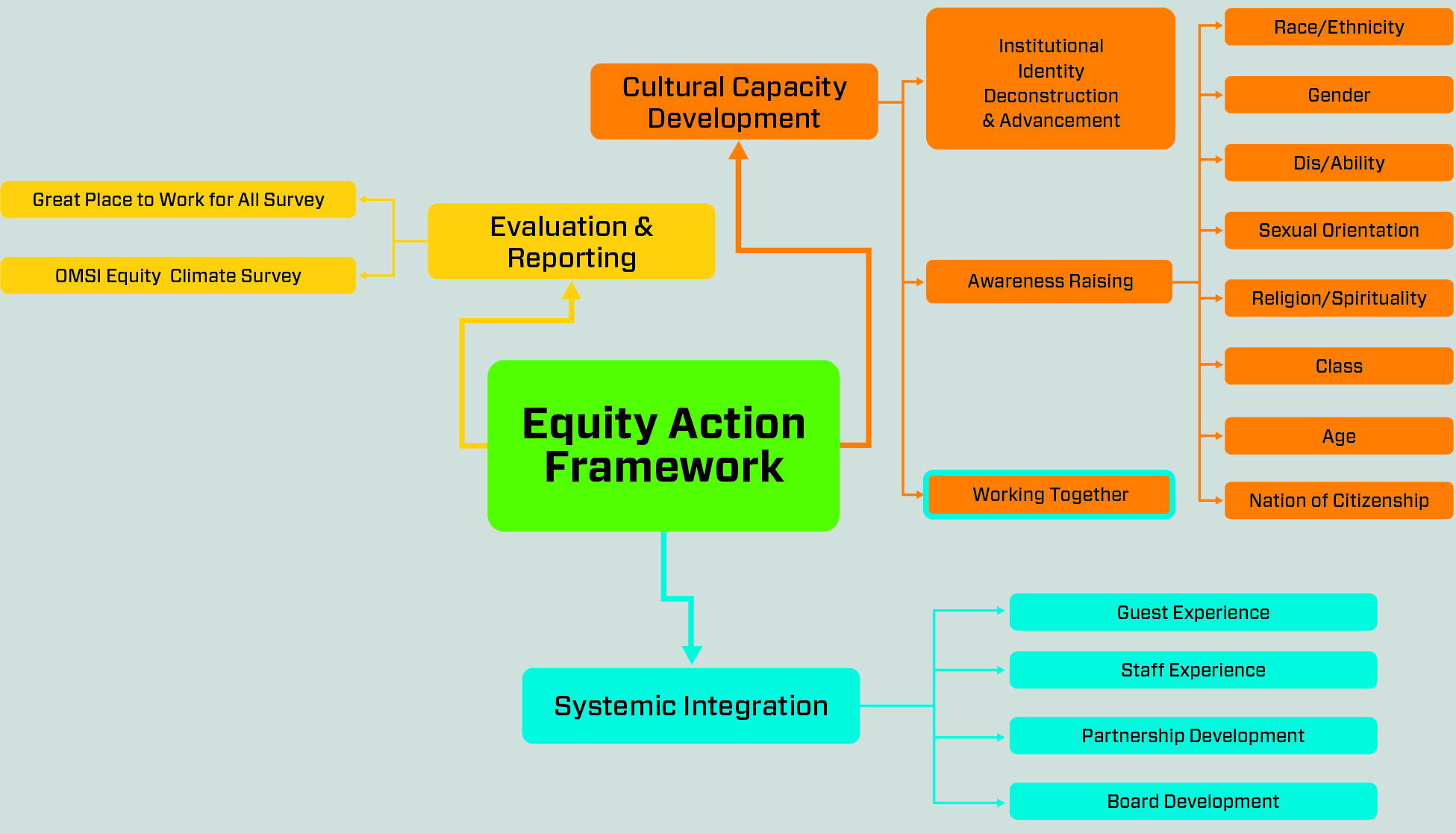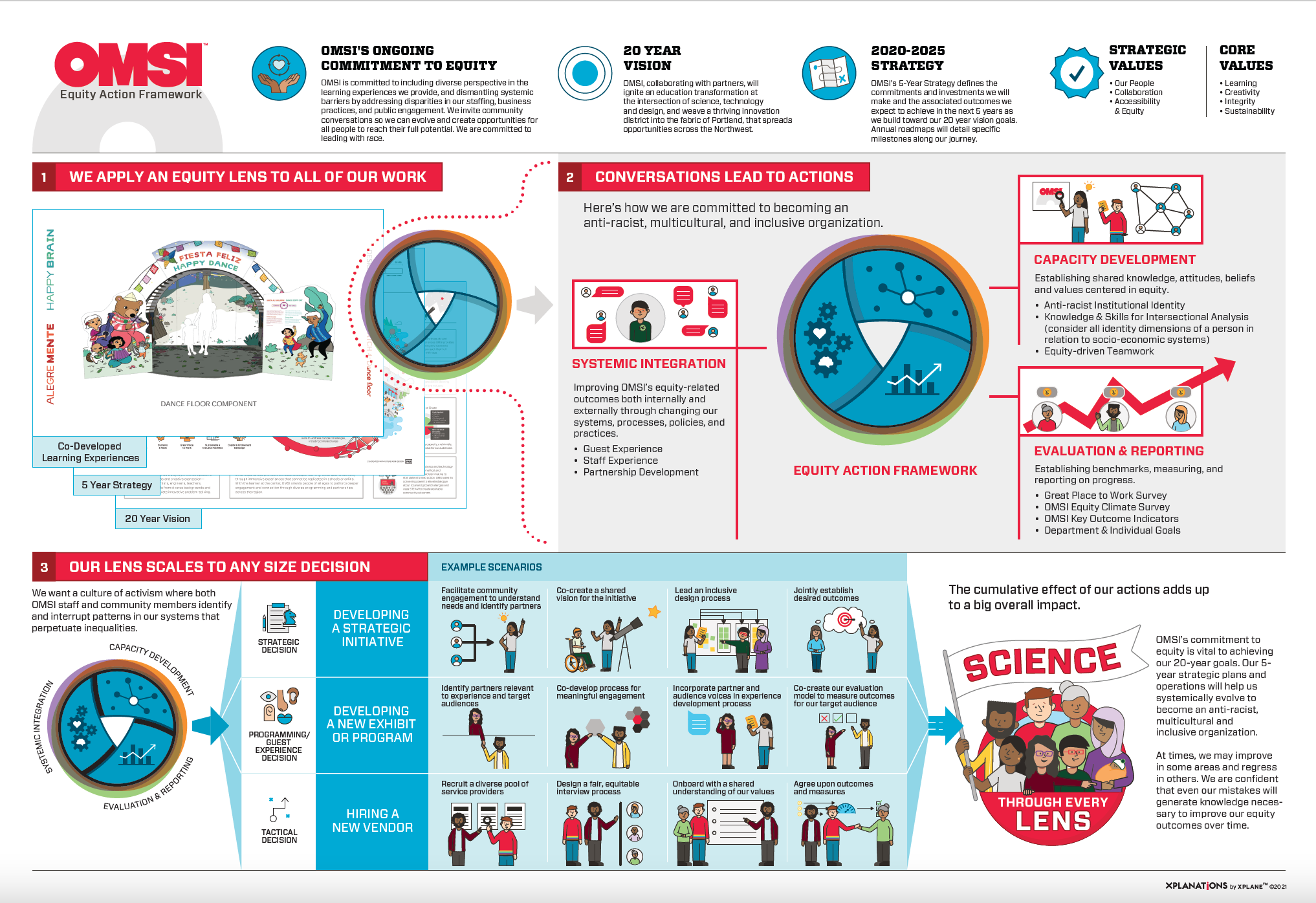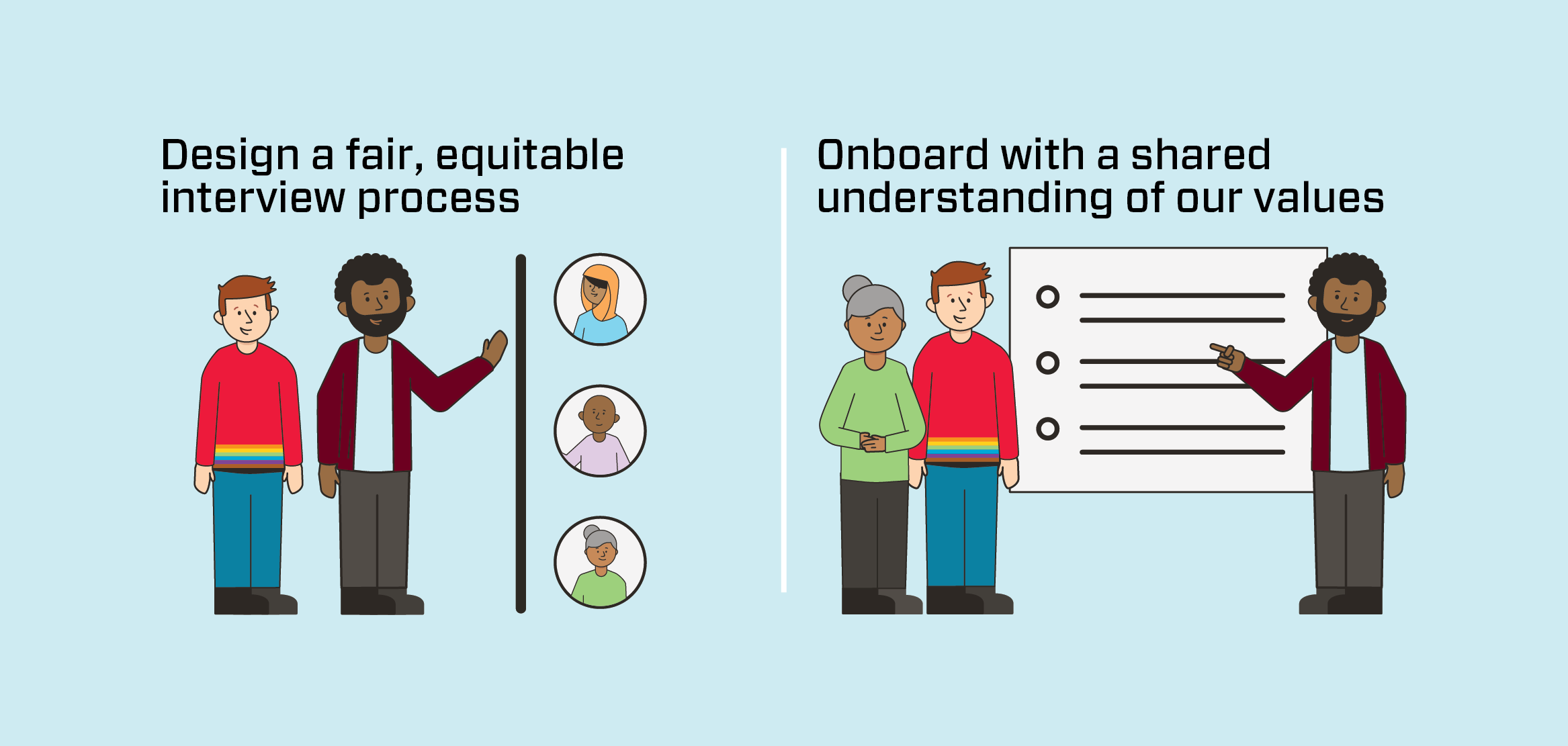At XPLANE, we aren’t experts in diversity, equity, and inclusion (DE&I), but we can help organizations visualize and activate their critical DE&I initiatives. What’s our secret? Collaborative design and people-centered visuals that communicate expectations, align and engage employees, and chart a clear path forward.
This was XPLANE’s task in a recent project with the Oregon Museum of Science and Industry (OMSI). OMSI had spent about three years of hard work to design and develop their Equity Action Framework (EAF). We set a goal to clearly communicate OMSI’s EAF through a visualization of it. In addition, we helped refine OMSI’s activation and communication plan.
OMSI’s framework is a holistic approach to Equity, Diversity, and Inclusion (EDI) that uses a lens of equity at the forefront of every decision made at the company. The framework is a brilliant way to navigate this continuous and complex work and it’s having a profound impact throughout the museum.
Using a Visual Lens to Get People Onboard with Change
Given OMSI’s impact on the Portland, Oregon community, OMSI’s EDI team knew they’d need to get everyone aligned and onboard with the framework to make positive change happen. So, they engaged XPLANE to help.
Working from a detailed document outlining OMSI’s thoroughly vetted ideas around the EAF, including a standard flowchart of thinking (see below visual), the OMSI team recognized early on that their EDI vision was a lot to digest. They understood the need for a clear plan to communicate the framework and ensure everyone was aligned in how this impacted their work moving forward.

XPLANE and OMSI both know that people learn in various ways and understand the science behind visual learning—75% of our brain’s sensory neurons are dedicated to visual processing. Of all the information our brains process, pictures are retained at far higher rates than words. This is called the “Picture Superiority Effect”. In fact, OMSI has historically used visuals to communicate key visioning, mission, and strategy messages. So OMSI’s EDI team determined they needed to apply a visual lens to their Equity Action Framework.
“Our equity values and goals need to drive decision-making in the same manner as our 20-year vision and 5-year strategy. These tools collectively guide our work,” shared Alexis Baghdadi, OMSI project manager. “XPLANE’s questions and concept drafts helped the OMSI team align on goals and priorities. Staff across the museum examined how a visual and activation plan could help drive a culture shift in which all staff disrupt patterns of inequity in our systems and practices,” she explained.
Developing a Map for Change
The first step was for the XPLANE team to transform what began as a nine-page narrative document to a one-page “map” depicting OMSI’s commitment to equity.
In creating the equity action framework, the OMSI team experienced a big “aha moment” while contemplating the many audiences that would need to buy into the framework—not to mention the training that would be required to ensure people throughout the organization adopted this way of working.
To help reach the various audiences within OMSI, generate buzz around the initiative, and lay out a plan for bringing the framework to life, XPLANE worked with OMSI to develop an activation strategy that used the EAF visualization as a core element. Designed to be flexible enough to be built upon, the visual framework could also be broken down into individual elements for conversations and learning across many audiences.
“The EAF and related activation plan enabled us to pull together ad hoc and grassroots efforts from across the organization. These efforts provided a framework to help leadership think through short-, medium-, and long-term goals to begin shifting OMSI culture to be more anti-racist and multicultural,” shared Baghdadi.

Additional Benefits of Visualization
As a testament to the strength of this framework, the OMSI team identified that the map itself—as a visual communication tool—might be inaccessible to people with low to no vision. “It was important to apply our EAF as we developed the visual,” explained Alexis. So the team considered a couple key questions:
- Does this visual align with our equity values?
- How will we make it accessible for our many audiences?
Text to Voice Feature
In response to these questions, OMSI identified the best way to ensure accessibility was to include text to voice features in the visualization. XPLANE researched the best way to accomplish this, which was done by embedding alternate text to the visual file to allow a voice feature to explain the visuals being depicted in the file.
- Learning opportunity: XPLANE took this learning opportunity to heart and decided to include text to voice features in our future deliverables to all clients, whether requested or not.
Enhanced Awareness of Implied Messages
The team also considered explicit or implicit messages conveyed through the visual. Doing so spurred the group to examine implied messages about power-holding in the organization, the ways in which collaboration is depicted, and how staff with historically marginalized identities might see themselves represented in this work.
Explained Baghdadi, “We called out how common it is for visuals and images to center whiteness. Small details communicate more than we might realize.”
For example, in the original storyboard below, XPLANE illustrated ways in which the equity lens impacts decision-making at OMSI by presenting vignettes in which a white man appears larger than and more important than everyone else.

Using an equity lens to look at these visuals, this issue was called out and the team revised the original storyboard to better illustrate the very values OMSI wished to communicate, as shown below.

- We’re all learners: At XPLANE, we have embraced the power of co-creation to carry the work we do; and yet, through this project we learned that even in the presence of diverse perspectives, it is possible to weave biases into our work. The feedback we received from the OMSI team was taken to heart, leaving a lasting impression we seek to apply as we embark on supporting future clients.
Pushing Content Development, Breaking Down Silos
The completed visualization of the Equity Action Framework is the basis of OMSI’s toolkit of activation activities and communications. These tools support conversations across departments and the organizational hierarchy to begin building a culture where all staff own the responsibility to interrupt patterns in OMSI’s systems that perpetuate inequities.
OMSI managers and staff are using the EAF to set equity-based annual performance goals. Exhibit development teams are using the EAF to push content development, demonstrating increased confidence in engaging the public with social justice-oriented science content. Strategic initiative project teams are using the EAF as an organizing structure to break down silos across the museum, aligning disparate activities so that strategies and tactics dovetail with one another, strengthening both internal and external impacts.
Implementing Change for a Healthier Organization
As XPLANE’s collaboration with OMSI shows, meaningful change takes a great deal of analysis, discernment, questioning, and planning within a supportive environment. But the results—including some welcome surprises—can lead to equity-enhancing insights, greater satisfaction among employees, and confidence moving forward.
Additional Resources
Whether you’re embarking on a DE&I journey or another broad organizational change initiative, here are some of our top tools to help you on your way:
- Who/Do Framework – a handy framing device that helps you define an audience and what you want them to do (or do differently)
- Activation Curve – a tool that shows how people process information that helps you (1) determine who needs to be involved in a change process and (2) get clarity on where to start, where you need them to be, and by when
- How to Design a Strategy Execution Plan – a content-rich blog post that walks you through the five phases of designing a solid strategy execution, or activation, plan
As always, if you’d like more information or have questions or comments about this post, don’t hesitate to contact us!
